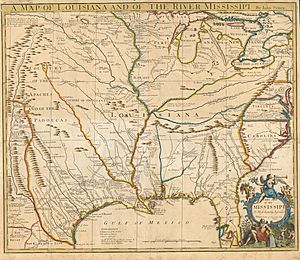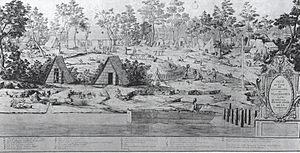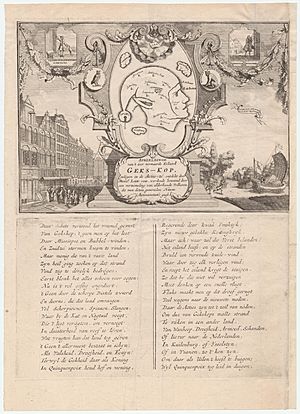Mississippi Company facts for kids
| Public | |
| Industry | International trade |
| Founded | 1684 |
| Defunct | 1721 |
| Headquarters |
France
|
The Mississippi Company was a powerful French business. It held special rights to trade in French colonies in North America and the West Indies. This company started in 1684. It was known by different names over time, like the Company of the West and the Company of the Indies.
The story of the Mississippi Company is closely linked to a Scottish financier named John Law. He was in charge of France's money at the time. The company's shares became super popular, leading to a wild rush of buying and selling. This event is known as the Mississippi Bubble. It's a famous example of an economic bubble, where prices go way up, far beyond their real value, before crashing down.
Contents
How the Mississippi Company Started

The Mississippi Company first began in 1684. This happened because Renee-Robert Cavelier (La Salle) asked for it. He was a French explorer who wanted to set up a colony at the mouth of the Mississippi River. His trip didn't quite work out as planned. He ended up starting a settlement near what is now Victoria, Texas, but it didn't last long.
In 1716, a Scottish economist named John Law became very important in France. He was the Controller General of Finances, meaning he managed France's money. Law created the Banque Générale Privée, which was a private bank. This bank was one of the first to use paper money. Most of its money came from government bills.
In 1717, Law bought the Mississippi Company. He wanted to help the French colony in Louisiana. He then created a new joint-stock trading company. It was called the Compagnie d'Occident, or "Company of the West." Law became its Chief Director. This new company got special permission from the French government. It had the only right to trade in the West Indies and North America.
The Royal Bank and Its Growth
In 1718, Law's bank became the Banque Royale, or Royal Bank. This meant that the King of France, Louis XV of France, guaranteed the bank's paper money. This made people trust the money more.
The company grew even bigger. It took over other trading companies, like the "Company of the East Indies" and the "Company of China." By May 1719, it was called the Compagnie Perpétuelle des Indes. This new company had a total monopoly on all French trade across the seas.
At the same time, the bank started printing a lot more paper money than it had gold or silver to back it up. This made the paper money lose its value. Eventually, people rushed to the bank to exchange their paper money for coins. This caused the value of the new paper currency to drop by half.
The Mississippi Bubble Bursts

France's King Louis XIV had spent a lot of money on wars. This left the country almost bankrupt. Instead of cutting back on spending, the Duke of Orléans, who was ruling for the young King Louis XV, listened to John Law's ideas about money.
In 1716, Law's Royal Bank was given a special agreement. The national debt of France was given to the bank. In return, the bank received amazing privileges. The main idea was that the national debt would be paid off using money from developing the Mississippi Valley.
Law's bank was connected to his other businesses. These included the Company of the West and the Companies of the Indies. All of these were known together as the Mississippi Company. This company had a special right to all trade and mineral wealth in the area. On paper, the company seemed to be doing incredibly well. Law was even given the title "Duc d'Arkansas."
Early French Settlements in Louisiana
In 1699, the French started their first lasting European settlement in Louisiana (New France). It was at Fort Maurepas. Pierre Le Moyne d'Iberville led this effort.
The first capital of New France, from 1702 to 1711, was La Mobile. After that, the capital moved to where Mobile, Alabama is today.
By 1718, only about 700 Europeans lived in Louisiana. The Mississippi Company helped bring in 800 more settlers in 1718. This doubled the number of Europeans living there. Law also encouraged German-speaking people, including those from Alsace and Switzerland, to move to Louisiana. They gave their names to places like the German Coast and the Lac des Allemands.
Wild Speculation and the Crash
Law made the wealth of Louisiana sound much greater than it was. He used clever marketing to get people excited. This led to a huge rush of buying the company's shares in 1719. People believed the Mississippi Company would be a massive success. They thought combining investor excitement with Louisiana's supposed riches would create a strong trading company.
The company's shares became incredibly popular. This created a need for even more paper bank notes. When investors made profits, they were paid with these paper notes. In 1720, the bank and the company joined together. Law was made the Comptroller General of Finances by the Duke of Orléans. This was done to attract more money.
Law's bank, which printed paper money, did well for a while. But then, the French government had to admit something important. The bank had printed far more paper notes than it had gold and silver coins to back them up.
The price of the company's shares reached a very high point, 10,000 livres. As shareholders started selling their shares, the amount of money in France suddenly doubled. This caused prices to rise very quickly, a problem called inflation. In January 1720, prices were going up by 23 percent each month.
People who didn't like Law tried to turn their paper money into gold and silver coins all at once. This forced the bank to stop giving out coins for its paper notes.
The "bubble" finally burst at the end of 1720. By September 1720, the price of shares had fallen to 2,000 livres. By December, they were down to 1,000 livres. By September 1721, the share prices had dropped to 500 livres. This was the same price they were at when the excitement first began.
By the end of 1720, the Duke of Orléans removed Law from his jobs. Law then left France and went to Brussels. He later moved to Venice, where he lived by gambling. He was buried in a church called San Moisè in Venice.
|
See also
 In Spanish: Compañía del Misisipi para niños
In Spanish: Compañía del Misisipi para niños


